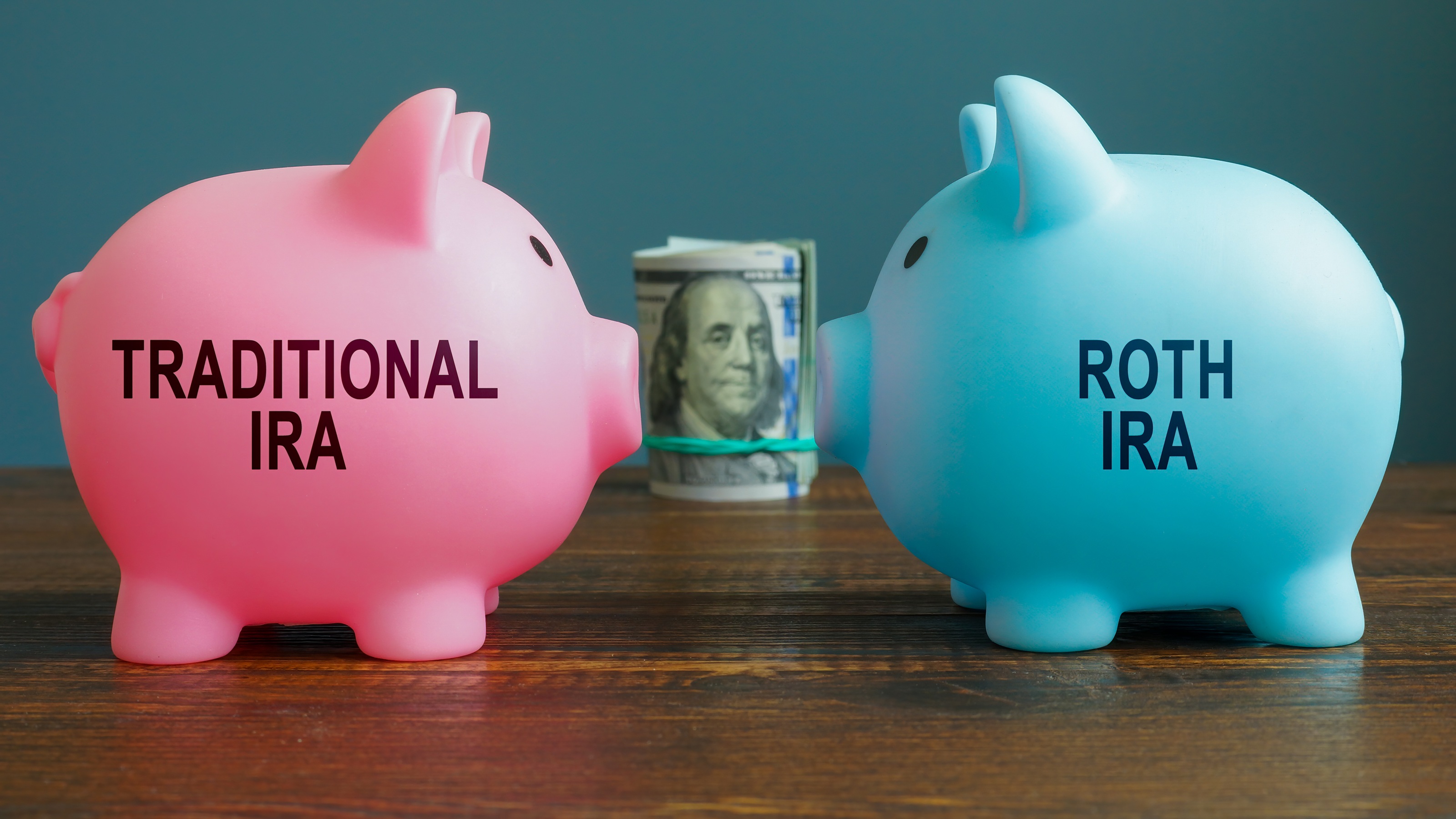Should You Convert a Traditional IRA to a Roth After 60?
You can convert a traditional IRA to a Roth no matter your age. But if the conversion boosts your income, it could have tax consequences.


It's not difficult to convert a traditional IRA to a Roth if you understand the tax implications, but the process may pose challenges for some people aged 60 and up. That may make you question whether you should do it.
Converting a Traditional IRA to a Roth IRA after age 60 can offer tax-free withdrawals, a tax-free inheritance for beneficiaries, and no required minimum distributions, all of which provide tax diversification and estate planning benefits.
That's the good news. On the other hand, the upfront tax cost of conversion can be substantial, with limited time to recover through tax-free growth. On top of that, the increased taxable income may lead to higher Medicare premiums or taxes on your Social Security benefits.
From just $107.88 $24.99 for Kiplinger Personal Finance
Be a smarter, better informed investor.

Sign up for Kiplinger’s Free Newsletters
Profit and prosper with the best of expert advice on investing, taxes, retirement, personal finance and more - straight to your e-mail.
Profit and prosper with the best of expert advice - straight to your e-mail.
Why older savers should (or should not) consider Roth IRA conversions
Because traditional IRAs have been around longer, older savers are more likely to own a traditional IRA over a Roth IRA. Also, older savers may be wary of executing a conversion or may not know about this option. Still, if you're over 60, there's much to like about Roth conversions.
You can contribute to a traditional IRA at any age if you have earned income. But can someone aged 73 still roll over money from a traditional IRA to a Roth in retirement? Do you need to have earned income to make a successful conversion?
Is a Roth IRA conversion wise for those over 60? Let's break it down.
Who can convert a traditional IRA to a Roth IRA?
There's no age limit or income requirement to convert a traditional IRA to a Roth IRA. You must pay taxes on the amount converted, although part of the conversion will be tax-free if you have made nondeductible contributions to your traditional IRA.
Once the money is in the Roth, you can take tax-free withdrawals. (You may have to pay taxes on any earnings withdrawn within five years of the conversion, but only after you've withdrawn contributions and converted amounts.)
See Roth IRA Basics: 10 Things You Must Know for more about tax implications on withdrawal.
Possible financial consequences of a conversion
Because converting to a Roth can have a ripple effect on other areas of your finances, be careful before making a big conversion in one year. For instance, the conversion will be included in your adjusted gross income, which could bump some of your income into a higher tax bracket and could also cause you to pay more for your Medicare premiums and higher taxes on your Social Security benefits.
Social Security
The Social Security Administration (SSA) determines who pays an income-related monthly adjustment amount (IRMAA) based on the income reported two years prior. So, the SSA looked at your 2023 tax returns to see if you must pay an IRMAA in 2025. Similarly, SSA will examine your 2024 tax returns to determine whether you must pay IRMAA in 2026.
The extra income from the conversion could also increase the portion of your Social Security benefits that is subject to income taxes. So, if you're already drawing Social Security, a Roth conversion could increase your income enough to have an impact. This is one reason why it’s beneficial to convert a traditional IRA to a Roth when you're younger, before you're drawing Social Security.
Medicare
If your adjusted gross income (plus tax-exempt interest income) is more than $103,000 if you're single or $206,000 if married filing jointly, you will have to pay the Medicare high-income surcharge for Parts B and D.
In 2025, people subject to the surcharge pay an additional $74.00 to $443.90 per person each month, depending on their income, for Medicare Part B premiums. They also pay a high-income surcharge of $13.70 to $85.80 above their Part D premiums.
See Medicare Premiums 2025: IRMAA Brackets and Surcharges for Parts B and D for more information.
For 2025, Medicare beneficiaries with income over $106,000 (for single tax filers), $212,000 (for joint filers), and $106,000 (for married people who file separately) will pay the surcharge. For these beneficiaries, total monthly Part B premiums will range from $259 to $628.90, for Part D premiums will range from $60.20 to $132.30.
See What You Will Pay for Medicare in 2025.
The basic premium for Part B is $185.00, an increase of $10.60 from 2024. Part D premiums decreased to $46.50 monthly in 2025, down $7.45 from $53.95 in 2024.
Keep an eye on RMDs in the year you convert your traditional IRA
Keep in mind that rolling money over from a traditional IRA to a Roth after 70-½ won't reduce your required minimum distributions (RMDs) for the year of the conversion; the required withdrawal is based on your IRA balance as of the end of the previous year. But it can reduce your RMDs for future years.
Instead of making one big conversion, consider rolling over a portion of the money from a traditional IRA to a Roth every year, with a close eye on the top of your tax bracket and income limits for the Medicare high-income surcharge and Social Security taxes.
Why converting a traditional IRA to a Roth IRA after 60 might be right for you
If you're over 60, converting a traditional IRA to a Roth IRA can be a smart financial move. Roth IRAs offer tax-free withdrawals in retirement, which can benefit older savers who may expect higher future tax rates or who want to avoid RMDs. Another perk is that no earned income is needed for a conversion, so a 73-year-old can still roll over funds.
On the flip side, the conversion triggers immediate taxes on the converted amount, which may not help you financially, especially if funds are tight or tax rates are expected to drop. Older savers may hesitate due to tax concerns or simply because of a lack of awareness, but a Roth conversion could provide long-term tax advantages and estate planning benefits. Still have questions? Consulting a financial advisor is key to assessing personal goals.
Related Content
Profit and prosper with the best of Kiplinger's advice on investing, taxes, retirement, personal finance and much more. Delivered daily. Enter your email in the box and click Sign Me Up.

As the "Ask Kim" columnist for Kiplinger's Personal Finance, Lankford receives hundreds of personal finance questions from readers every month. She is the author of Rescue Your Financial Life (McGraw-Hill, 2003), The Insurance Maze: How You Can Save Money on Insurance -- and Still Get the Coverage You Need (Kaplan, 2006), Kiplinger's Ask Kim for Money Smart Solutions (Kaplan, 2007) and The Kiplinger/BBB Personal Finance Guide for Military Families. She is frequently featured as a financial expert on television and radio, including NBC's Today Show, CNN, CNBC and National Public Radio.
- Donna LeValleyRetirement Writer
- Kathryn PomroyContributor
-
 3 Ways High-Income Earners Can Maximize Their Charitable Donations in 2025
3 Ways High-Income Earners Can Maximize Their Charitable Donations in 2025Tax Deductions New charitable giving tax rules will soon lower your deduction for donations to charity — here’s what you should do now.
-
 Another State Quietly Bans Capital Gains Taxes: Will Others Follow?
Another State Quietly Bans Capital Gains Taxes: Will Others Follow?Capital Gains A constitutional amendment blocking future taxes on realized and unrealized capital could raise interesting questions for other states.
-
 How to Calm Your Retirement Nerves When It's Time to Shift from Savings Mode to Spending Mode
How to Calm Your Retirement Nerves When It's Time to Shift from Savings Mode to Spending ModeTransitioning from saving to spending in retirement can be tricky, but devising a strategic plan can help ensure a smooth and worry-free retirement.
-
 Why Wills and Trusts Aren't Enough in the Great Wealth Transfer, From an Attorney Who Knows
Why Wills and Trusts Aren't Enough in the Great Wealth Transfer, From an Attorney Who KnowsFamilies need to prepare heirs through communication and financial know-how, or all that money could end up causing confusion, conflict and costly mistakes.
-
 Private Markets for Main Street: What Financial Advisers' Clients Need to Know
Private Markets for Main Street: What Financial Advisers' Clients Need to KnowWith product innovation 'democratizing' private market access for everyday investors, advisers must step up their game to educate clients on the pros and cons.
-
 I'm 58, Divorced, and Dating Again, but Women Just Seem to Care About the Size of My Bank Account
I'm 58, Divorced, and Dating Again, but Women Just Seem to Care About the Size of My Bank AccountDoes size matter? We ask experts in dating, financial planning and law for advice.
-
 Seven Practical Steps to Kick Off Your 2026 Financial Planning
Seven Practical Steps to Kick Off Your 2026 Financial PlanningIt's time to stop chasing net worth and start chasing real worth. Here's how to craft a plan that supports your well-being today and in the future.
-
 A Retirement Plan Isn't Just a Number: Strategic Withdrawals Can Make a Huge Difference
A Retirement Plan Isn't Just a Number: Strategic Withdrawals Can Make a Huge DifferenceA major reason not to set your retirement plan on autopilot: sequence of returns risk. Here's how to help ensure a bad market won't sink your golden years.
-
 I'm Embarrassed to Ask: What Is a Life Insurance Trust?
I'm Embarrassed to Ask: What Is a Life Insurance Trust?Life insurance trusts, particularly irrevocable life insurance trusts (ILITs), can minimize estate taxes and protect your heir's inheritance.
-
 I'm 61 and need $50,000 for home repairs. Should I borrow, given today's rates, or take a withdrawal from my $950,000 401(k)?
I'm 61 and need $50,000 for home repairs. Should I borrow, given today's rates, or take a withdrawal from my $950,000 401(k)?We asked financial experts for advice.